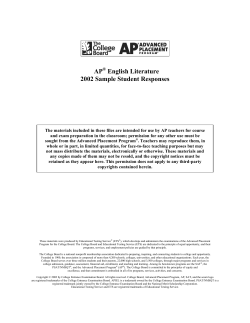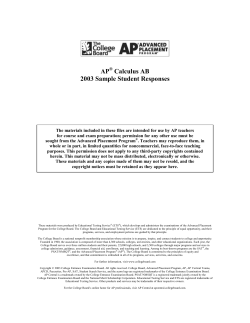
European Parliament Lunch Debate âTHE MISSING LINK â Is there
European Parliament Lunch Debate ”THE MISSING LINK – Is there a future for other carbon markets joining the EU ETS?” - Meeting Report 5 May 2015 Carbon Market Watch organized a lunch debate in the European Parliament on Tuesday 05/05/2015, kindly co-hosted by MEPs Giovanni La Via (EPP), Matthias Groote (S&D) and Bas Eickhout (Greens/EFA). The debate outlined the opportunities and obstacles as well as the state of play for linking carbon markets with that of the EU. With negotiations ongoing between the EU and Switzerland to link their emissions trading systems (ETS), questions are being raised about the risks and benefits of such a measure and the effects this will have on carbon prices. Although the impact of linking the Swiss and EU ETS is relatively small, linking the EU ETS to, for example, the South Korean or the future Chinese carbon market could have far reaching implications for EU’s climate policies. In this context, the panelists discussed the progress of developing China’s regional ETSs into a national system as well as future climate actions envisioned by the Chinese government. The launch of a new policy briefing and report by Carbon Market Watch provides details on which principles need to be adhered to and included as criteria for linking in the revision of the EU ETS directive in order to ensure that any future linking does not compromise the integrity of climate policies. Key highlights can be summarized as follows: To avoid diluting the EU’s climate ambition, linking should be coupled with a higher emission reduction target. Given that the main benefit of linking is to reduce costs for companies by increasing the pool of available emissions reductions, this should be possible at no additional cost. For national ETSs to be linked, adequate criteria must be put into place to safeguard climate targets. Jurisdictions with emissions trading now account for 40% of global GDP. As more countries adopt carbon pricing the argument for carbon leakage becomes weaker and ultimately irrelevant. The Swiss ETS will include aviation after linking to align it with the EU ETS; however, the question if the Swiss carbon market will allow international offsets after 2020 is still unclear Linking negotiations are a long and complex process as they combine the bureaucratic complexity of two governments that must reach domestic and then international consensus on the topic. The Chinese system is a ways away from being ready to link. Nevertheless, it will be interesting to see how the nation handles “linking” their regional pilot markets into a national system starting in 2016. The full event can be viewed via web stream. To enter the video, please click here. Below is a short summary of the presentations and discussion: Bas Eickhout (MEP, Greens/EFA) gave the opening remarks for this event and stressed the importance of transparency in the linking negotiations. He underlined the pressing issues of the current negotiations including common target setting, how to decide on the sectors covered, and what to do with surplus allowances. Damien Meadows (DG CLIMA, European Commission) presented an overview of the ongoing linking negotiation process between the EU and Switzerland. He gave examples of the previous EU ETS linking experiences with Norway, Iceland and Liechtenstein, which were integrated during the creation of the ETS directive, and the failed linking attempt with Australia. He remarked on the limited political interest in the Swiss linking negotiations and outlined the EU’s conditions for linking. While certain aspects need to be ironed out, he explained that the Swiss and EU markets are largely compatible. The main points of his presentation included: Carbon pricing is fundamental to effectively fight climate change, but economically tricky to establish. Europe has a great opportunity as a front runner in the creation of carbon markets to influence the formulation of these schemes elsewhere. The Swiss system has a narrower scope than that of the EU, with aviation currently excluded from the sectors covered. Switzerland will be required to provide evidence about a proper inclusion of aviation emissions within its scheme. The Swiss scheme fills compatibility requirements concerning a mandatory participation framework and an absolute emission cap in place. The question of Switzerland’s use of international offsets after 2020 remains unclear. The linking negotiations with Switzerland have been ongoing on for the last 4 years. The agreement is expected to be finalized in 2015. Sophie Wenger (Climate division, Swiss Federal Office for the Environment) summarized the current status of the Swiss climate action and, as part of the negotiating team, she provided thorough reasoning to explain why the Swiss and European ETSs should be linked. She then outlined the remaining differences between the Swiss and the EU ETS that the negotiations should harmonize. The main points of her presentations included: The Swiss and European ETSs are largely compatible. Their main differences currently include sector coverage and scale. The Swiss scheme excludes power plants and the aviation sector. Overall the Swiss cap accounts for 0.3% of the EU cap, so there will be no significant change to the EU ETS when the linking happens. Until 2030, Switzerland intends to reduce emissions by 50% compared to 1990 levels including the use of international offsets. At least 30% shall be domestic. Linking will be able to give a fundamental political signal, showing and strengthening the collaboration between Switzerland and the EU. Li Shuo (Alexander van Humboldt Fellow) covered current developments of China’s regional ETSs and outlined the plans for a national market. He emphasized that, while international linking is improbable in the short term, when China is ready to negotiate linking its national system with the systems of other countries they would want to be a rule shaper in the debate. For now the focus is on expanding and linking the seven regional pilot systems into a larger harmonized market. In his presentation he highlighted the following: China wants to have a leadership role in the climate debate and intends to expand their pilot carbon markets into a national carbon market from 2016 onwards. International linking is currently a long shot. Connecting regional markets will be in and of itself a difficult linking exercise. China’s seven regional ETS face compatibility issues concerning registries, MRV and included sectors, all of which will have to be harmonized at the national level. Femke de Jong (Policy Officer, Carbon Market Watch) talked about the risks of linking the EU ETS to other carbon markets. She highlighted the impacts of EU ETS linking on the EU carbon price and on the amount of auctioning revenues as well as the negative effects of linking systems with differing standards, specifically as it relates to carbon offsets. Through the comparison of other carbon markets around the world she emphasized important recommendations to be taken into account for reforming the EU ETS: A decision to link the EU ETS to other carbon markets needs to result in increased climate ambition in the EU. Critical features to consider when linking different carbon markets include the stringency of the target, the use of carbon offsets and the price and supply controls of both systems. Negotiations should be more transparent with a bigger role for the European Parliament The upcoming EU ETS revision should introduce safeguards for any decisions to link the EU ETS to other carbon markets Giovanni La Via (MEP, EPP) concluded the event thanking the organizers. Citing the MSR debate as well as the linking negotiations, he remarked upon the growing complexity of the political process, but added that both conversations were necessary and would endure.
© Copyright 2025









